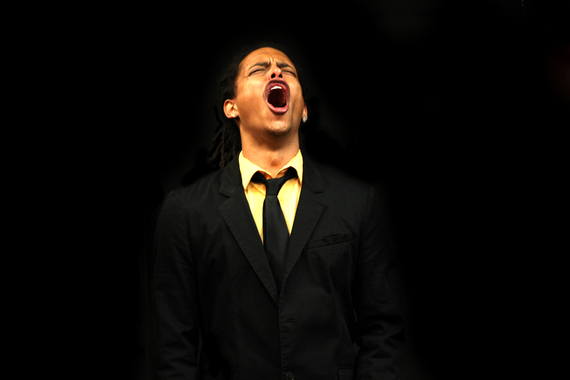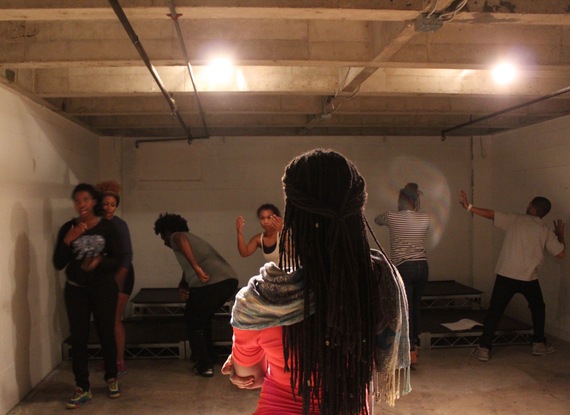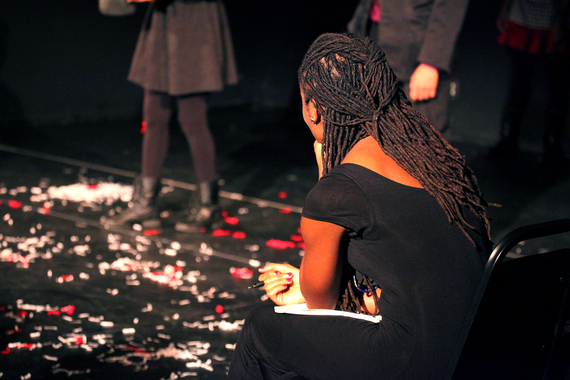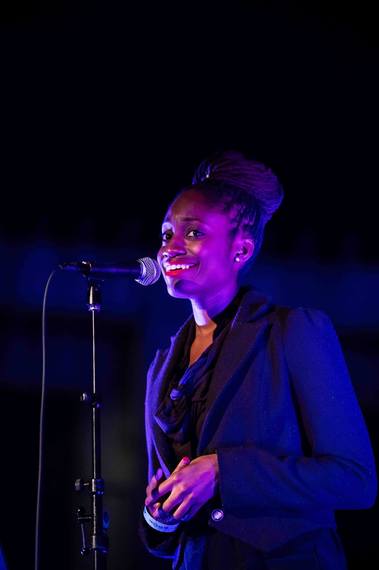
"What To Send Up When It Goes Down" is a ritual performance created by Aleshea Harris as "a tool that communities can access when they're in crisis after someone has been killed." (Photo by B. Justine Jaime)
A shocking act of racial violence brings Harold Pinter's "The Room" to an abrupt close.
I did not know this before I went to see the Wooster Group's take on the 1957 play in February, during the production's premiere run at REDCAT in downtown Los Angeles (a production that, incidentally, met its own sudden demise due to licensing issues with Pinter's estate).
Having arrived at the theater near showtime, with practically every seat taken, I was guided by an usher down the steep side aisle to the very front row. My proximity to the action made for an unusually intimate experience of the Wooster Group's trademark alchemy of language, gestures and technology, precise masterworks of breakdown and re-assemblage, postmodern seams always showing. I've attended numerous shows presented by the company over the past two decades, starting when I lived in New York in the 1990s. The work is provocative, demanding, discomfiting.
Despite such expectations I was not prepared for the brutal beating of the "blind Negro," as the character Riley is described in Pinter's stage directions, delivered out loud by a narrator. Wearing long tight braids that fall past his shoulders and tapping a red-and-white cane, Riley's arrival terrifies the middle-aged couple, Rose and Bert, who already live in fear of everything and everyone beyond the seeming security of their rented room. Whether he is a total stranger or someone from Rose's past, we will never know. What we do know: He does nothing to provoke the violence about to be unleashed.
Speaking not a word to the unexpected visitor, Bert topples the chair on which Riley is seated, throwing him to the floor, then kicks him repeatedly and stomps on his head. It all happens fast yet goes on unbearably long. Because I am seated so close I am able to see, under the table where Riley has collapsed, how Bert's shoes are pounding the floor, not the actor's body, and how the sound is amplified by an audio engineer seated just a few feet from me.
Theatrical artifice notwithstanding, the scene explodes with visceral power.
Sixty years since "The Room" was written, the scene of white men perpetrating violence on black men has become all too familiar, as cold fact and also as boiling-over artifact, viral videos on instant replay positioning us, as viewers, in front row seats at the beating, the shooting, the killing, as it goes down.
The L.A. poet and regional curator for #BlackPoetsSpeakOut, Ashaki M. Jackson has written a searing cycle of poems probing this phenomenon, titled Surveillance. Published as a chapbook by Writ Large Press, it raises urgent questions about such killings and the public's consumption of the videos documenting them. Jackson writes: "If you watch enough footage you grow / comfortable with a narrative: / the Black body will die."
In an era of social media that atomizes our reception of such incidents even as it has the potential to unite us in our response to them (#BlackLivesMatter), young artists around the country are articulating new performative modes of mourning and resistance. Some of the most remarkable work is happening under the elite-culture radar.
In my own community of Altadena, California, poet and activist Khadija Anderson founded the monthly series Poets & Allies for Resistance as a platform for poets of color and other writers. It was there this past December, at the black-owned Sidewalk Café, that I first encountered Aleshea Harris, a graduate of the School of Theatre at CalArts, performing her startling spoken word piece, "Red Eye," addressing the destruction of black bodies.
That same evening featured Harris's CalArts mentor, award-winning poet and Altadena native Douglas Kearney, whose readings are a performative tour de force. Harris shares Kearney's electrifying stage presence but delivers her work entirely off the page. She embodies tightly coiled, lyrical yet fractured monologues expressing a fierce yet precarious hold on reality--the disturbing, sometimes lethal, reality her characters are forced to inhabit.
While still in school, Harris began work on "What To Send Up When It Goes Down," a ritual performance that she now brings to communities confronted by loss. Finding inspiration in Theater of the Absurd, particularly the work of Eugène Ionesco, along with contemporaries like Suzan-Lori Parks, she upends theater as entertainment and reaches back to its ancient roots as a rite of communal participation and transformation. Engaging with smaller audiences in community settings, she unapologetically privileges black voices and black viewers.
The American Conservatory Theater (A.C.T.) in San Francisco premiered Harris's newest work, "Crack. Rumble. Fly.: The Bayview Stories Project," on June 18 and 19. Inspired by Sophocles' Oedipus the King and created in collaboration with local residents, Harris's script grew out of a series of story circles in Bayview-Hunters Point. Through words, music and movement, a multigenerational cast of performers addresses themes of displacement, marginalization and police brutality within the African American community.
For our interview I sat down with Harris back at the Sidewalk Cafe in Altadena, and we continued the conversation over email.
Just as I was diving into your work, I saw a performance of "The Room" for the first time and I was struck by how the black character serves as mere symbolic stand-in for everything the white characters fear, and how there's zero interpretation or critique of the violence the audience has just witnessed. It seems to me that your work, including "What To Send Up When It Goes Down," thoughtfully and by design privileges black voices in an attempt to honor those lost to racist violence. While building on the aesthetic legacy of absurdist theater like "The Room," you pick up where it leaves off: the brutalized black (male) body collapsed in dead silence on the ground.
You are so right. "What To Send Up" picks up the black bodies shoved into the margins and left to fester in the streets. It tells the stories dominant culture does not want told, does not care to tell. It speaks to the re-trauma of being violently accosted in white art without any level of critique or reflection. This casual violence is maddening, as is the use of a black body for white coming-into-consciousness. As you said, I very intentionally center black voices with "What To Send Up." The piece isn't slanted for dominant culture's consumption.
How do you see your work in relation to absurdist theater?
Absurdist theater feels like home. Whenever I experience it, I'm like, well, that just makes so much sense to me. And I think our time here is so absurd, that's what I want to capture--the madness of it. But I often think about the irony of using historically European theater practices and idioms to challenge white supremacy. The Absurdist movement is named by and attributed to Europeans. It is not lost on me that when Martin Esslin coined the phrase in the 60s, he was speaking primarily about white, male playwrights.
"What To Send Up" is very, very different and also the same. Absurdism is a name for a way of responding to a world which no longer makes sense. It doesn't start or end with Europe in the 1950s, though dominant culture would have us think so. I believe that Absurdism may be found in every corner of the world wherein people find themselves alienated from their homes, what they had perceived as truth, etc. It dwells wherever there is trauma, and certainly there is trauma in the existence of black people in America. I use the term because I am a product of the West living in the West where it is shorthand for describing a set of theatrical conventions.
Who are some of the artists and writers that have moved and inspired you?
For "What To Send Up" in particular, I drew inspiration from Suzan-Lori Parks, Adrienne Kennedy, Augusto Boal and the multitude of Southern spoken word poets and activists I've come into contact with. In the theater I very rarely experience the kind of community and transmission that I experience at Southern Fried Poetry Slam that I would go to every year. It's unbelievable.
I really love Octavia Butler, who was a Californian, and also Toni Morrison. Lately I am enjoying listening to Nina Simone's "Nina Sings the Blues." Everybody knows Nina Simone is a genius. But I think that her brilliance is that she understood where she was and her place in that landscape, and she didn't try to sugarcoat any of that. And she paid the price.
You went to the University of Southern Mississippi for your B.A. and then moved to Florida and started doing spoken word. In 2014 you completed a master's degree at CalArts in Writing for Performance. What's the relationship for you between poetry and theater?
I studied theater, but I was focused on being an actor, and I noted that people seemed to have a very narrow view of what kind of space my body could occupy on stage--and I found that really frustrating. I decided to write plays.
And Florida is where I discovered spoken word. I was slamming. I was competing, and I won a couple things and met some amazing people who were hugely influential, and I felt supported and nurtured as an artist.
Around that same time I decided to take writing for the stage more seriously. With a couple of other women playwrights, Heather L. Jones and Roxanne Fay, I started a collective called the Blue Scarf Collective, and we were committed to putting up our work, and we were also committed to diversity.
I think that the poetry has really fed my dramatic practice. It certainly fed the way that I use language and the way that I view language as a tool, as a thing that is alive. I think it goes back to this idea of embodiment. I am also interested in the performance of the language on the page, and what that could signal to a body--signal to a performer--and what it does that a performer's body can't do.
Whether spoken word or theater or musical performance, there's a spareness to much of your work, how you work with very minimal resources, very basic materials.
I was telling someone recently about how I write for broke-ness. And it's because I've been in situations in my life where I didn't have much. And as a creator it's always important to me to do as much as I can, no matter how little it seems like I have. So I think that you can create a thing of great beauty with limited resources. I found that it pushes me to be more creative, because I can't rely on any sort of spectacle. I try to write away from that [sets, costumes, lighting] because I don't want for that to be like a safety net. So in terms of the spoken word, what I love about that form is that I don't need much. If I have an idea and there's something that needs saying, I can go and say it. It doesn't work that way in the theater.
Of course I love the art form of the theater as well, but there is a need for more resources, which can be very challenging. But within those constraints, I never feel like I need a lot, or that I need a lot that's extravagant by any means. I may want a pile of dirt or something like that. I like accumulation but it's an accumulation of a material that is not readily viewed as a material of value, and that's really exciting to me.
Have you actually used dirt as a material?
I have, with my first solo show, "Oddlie," which is the play that got me into CalArts. The first version of it went up in Florida, and I took it to the Edinburgh Festival. It's very heavily spoken word. It's a long poem, essentially, that I perform with a musician. Yeah, there was dirt. [Laughs.] And then with my thesis play at CalArts, we had sand, and they actually took it out because they were afraid of it getting into people's lungs.
"What To Send Up When It Goes Down" is a ritual response to the death of black people due to racialized violence. Where and how did you develop the piece?
I workshopped it first at CalArts. I came in with a script that I had worked on by myself and in class with Doug [Kearney]. And then I had this workshop and I allowed myself to be influenced by who was in the room, and to write towards what they can do. And so in that way, it wasn't exactly devised, but I definitely made use of the talented folks who were there.
We did it in L.A., and then we took it up to the Costume Shop, a black box theater at the American Conservatory Theater. So the piece has grown, and it's maturing. It's a piece that is, ideally, a tool that communities can access when they're in crisis after someone has been killed. I feel very strongly that we need tools. Every oppressed population, every marginalized population needs tools for coping, and I hope that this can be one for black people.
Can you describe the participants' experience of the piece?
It begins as a communal experience and we invite the audience in, and we go through these actions, like speaking the name of someone who's been killed, once for every year that they lived; one word for how you feel now; a word for how you'd like to feel, etc. And then it turns into a parody of well-worn racist tropes in American theater and cinema and then these poetic riffs about different experiences of racism in different spaces. And it's really intense. People always have strong emotional responses, because we open them up--or we allow them to open themselves and be a part of it. It's a real ritual. I don't want it to be treated like a play.
People recognize the intensity of your work across all of its forms. What does it feel like to have that kind of artistic power?
Sometimes I don't know what to do. Like, when we first did "What To Send Up," some people at CalArts were weeping, and they would have a story for me about when they experienced racism. I hope that the piece is a catalyst. It usually is. At the very least, there's conversation.
How do you go about taking the piece into a community that's experienced racialized violence?
What I would want to do, first of all, is have a producer, someone who has experience in community engagement in a way that I don't. And then what I think makes sense is to say, "We have this thing. If you are open to it, if you are interested in it, it exists." So it's not about imposing anything. It's not about, "We're the grief professionals, we can help you." It's just about going, "Here's a thing that's worked for us." The idea is to do something to affirm.
Do you see a place for "What To Send Up" in the context of interracial work on anti-racism?
Anyone can view the ritual. But it's important to me that it be black people who carry it out. It's important that it centers black experiences, and it isn't about offering a solution. So it really is a space--I called it an "anger spittoon"--where you can come and be freely mad. Because a lot of times unfortunately what people outside of the experience say, or don't say, or say without saying, is that you shouldn't be mad about it, that you just need to get over it and carry on, and I think that that takes a toll. So we have to have a place to put it. And we also have to center black experiences, which we don't always do, even in conversations about anti-black racism.
Last fall you went to Ferguson to make new work. What was that like?
I was part of the "Every 28 Hours One-Minute Play Festival," a collaboration between The One-Minute Play Festival and Oregon Shakespeare Festival. They issued a call for playwrights to make one-minute plays around this issue of racialized violence against black people. "Every 28 Hours" refers to the statistic that every 28 hours in America, a black person is killed by the police. I met some amazing socio-politically engaged theater artists. That was, I think, a really important part of being there--seeing how many other people are invested in this cause.




